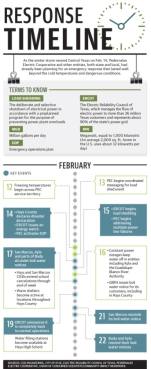A winter storm that sidelined many Central Texas residents in mid-February led to an emergency services disaster declaration throughout Hays County, and most in the region are still recovering.
The havoc caused by the severe weather led to school and business closures, mass power outages, undriveable roads and loss of running water that resulted in several boil water notices.
The cold snap arrived late Feb. 14, and by Feb. 16, much of the state’s power suppliers were entering a second day of power outages.
Shane Billiot, co-owner of OMG Seafood in San Marcos, said his business was closed for the duration of the week, from Feb. 15-19, save for one day during which no money changed hands.
On Feb. 16, he opened his restaurant despite near ubiquitous hazardous road conditions. On that day, Billiot gave away all of the food at OMG Seafood to anyone who could make the trek to his shop.
“Not only was it Valentine’s Day weekend, but it was the weekend before Mardi Gras, and we have Lent that started [Feb. 17],” Billiot said. “So, I bought up [several thousand pounds of crawfish], and with this snowstorm happening, it prevented us from being able to operate.”
All told, Billiot gave away roughly $12,000 worth of food from both his San Marcos and Bryan locations, and he said he lost 100% of his revenue that week versus a normal week.
“This was an unprecedented event,” said Julie Parsley, CEO of Pedernales Electric Cooperative, during a Feb. 26 board of directors meeting. “It hasn’t happened in 150 years.”
By its own accounting, PEC is one of the largest electric cooperatives in the U.S. with more than 348,000 active accounts as of Jan. 1. Its coverage area spans the majority of Hays County, including nearly all of San Marcos, Buda and Kyle.
During the mid-February winter storm, data from PEC shows the company peaked at 1,993 megawatts of usage. That constitutes an increase of more than 42% compared with the 2020 winter usage peak and nearly 50% compared with the 2019 winter peak.
While more specific details have so far not been divulged, Hays County Judge Ruben Becerra said he will be working with city and county officials in the coming weeks to figure out what went well during this winter storm as well as how to better respond to future emergencies.
“I don’t know if there’s more to come, but I feel confident that we’re moving in the right direction,” he said.
Explaining the outages
When the weather event first started within PEC’s coverage area Feb. 12, Chief Operating Officer Eddie Dauterive said the power supplier activated its emergency operations plan, or EOP.
“The entire event lasted a week, and as everybody knows, it started with freezing rain, then snow, then freezing rain, then snow again,” Dauterive said. “So, it was a historic outage for this organization that we’ve never seen before.”
Dauterive said in the middle of the severe storm the company had to undergo an extended process of load shedding, which involves the deliberate shutdown of electric power in part or many parts of its system.
Ian Taylor, CEO for the nearby power company New Braunfels Utilities, said energy providers must undergo a load-shedding process—which essentially is the deliberate and selective shutdown of electrical power to prevent overloads at power plants—when their stored energy exceeds their generation output. If the power imbalance is not properly handled through load shedding, then suppliers could end up with catastrophic outages that could take weeks, even months to rectify.
By Feb. 14, PEC activated its full EOP after determining the freeze was going to constitute a prolonged event, Dauterive said.
Parsley said initial emergency operations involved monitoring the state power grid, called the Electric Reliability Council of Texas, or ERCOT, which accounts for 90% of the power load in Texas, minus areas including El Paso, the Panhandle and parts of East Texas.
“When we activated the EOP on Feb. 14, we were continuing preparations for load shed,” Parsley said. “We were trying to determine what we believed was going to happen.”
Late into Feb. 14 and into the morning of Feb. 15, Parsley said ERCOT began calling for power suppliers throughout the state, including PEC, to begin conserving power through load shedding.
Parsley explained that as temperatures kept dropping, demand for power kept increasing, which in turn required ERCOT to demand more load shedding from power providers.
Additionally, in late February, Taylor said a failure on the part of ERCOT to winterize the state’s coal, natural gas, nuclear, solar and wind infrastructure led to insufficient power generation across the state’s fleet of generators, which caused them to shut off.
“We got our first order to load shed at 1:23 a.m. on Feb. 15,” Parsley said. “It was really frightening. There was a period of time in there where it looked really dire.”
A communitywide effort
After PEC and other power providers in Hays County began implementing rotating power outages that would affect customers throughout the week, boil water notices were issued in San Marcos, Kyle and Buda.
On Feb. 16, San Marcos officials said 16,000-32,000 customers were without power, and three San Marcos CISD buses were used as warming centers for residents a day later.
City staff in San Marcos distributed thousands of bottles of water when the city issued a boil water advisory Feb. 17. Workers handed out 14,500 bottles of water Feb. 18, and another 11,500 bottles the next day. Authorities also directed residents to the VFW Hall on Hunter Road, where they were able to fill containers with water.
In the Kyle and Buda areas, officials organized two mass food-distribution events, one of which took place Feb. 20 at Lehman High School. Organizers said that ended up feeding 1,680 families affected by the outages. The second was scheduled for March 13 and was organized in conjunction with the Central Texas Food Bank and Texas Disposal Systems.
Warming shelters at Hays Hills Baptist Church and Silverado Crossing Apartments in Kyle were also activated, and soon after boil water notices were announced on Feb. 17, water filling stations were made available at Hays High School from Feb. 19-21.
Buda City Manager Kenneth Williams said city officials began preparing for the storm days before it arrived.
“Fortunately enough, we have our public safety building, City Hall and all that on gas generators,” Williams said. “We had our police department on standby. The night before, they started sleeping, basically, at the police station.
Other employees were sleeping at City Hall. We knew it was coming, so we were prepared.”
After the storm, volunteers led by the Buda Chamber of Commerce held an event called Mission Buda Cares to support the people and businesses of Hays County.
Rachel Patrick, a key volunteer for Mission Buda Cares, helped organize a large part of the effort by picking up supplies from various sources.
“It went wonderful, and I couldn’t believe the people that showed up,” Patrick said. “People who needed help the most showed up to help others. It was such a great success, and I was really proud of all of [the efforts]. There
wasn’t a day that we didn’t have enough people to help out.”
The event ran from Feb. 25-28 and provided meals to an estimated 31,000 Hays County residents, first responders and essential employees, according to information from the Buda Area Chamber of Commerce.
Mayor Lee Urbanovsky said that from the onset of the severe weather, officials set up warming stations in tandem with Hays County. However, he said they were not needed until all of the residents at Creekside Villas Senior
Village had to be evacuated due to power outages and burst pipes that caused flooding at the facility.
“We had that in place, and we learned some lessons from that,” Urbanovsky said, adding the city of Buda likely fared a little better than other municipalities with regard to water.
Assessing what can be done
Representatives from the PEC declined to speak with Community Impact Newspaper for this story, but during the Feb. 26 board meeting, Dauterive said moving forward it is going to be critical for the cooperative to examine its
infrastructure and figure out how to more effectively balance load shed and spread it more evenly throughout its network in preparation for a future severe weather event.
“We need to really establish those relationships with our cities and identify the critical infrastructure and help them identify proper systems—generator backups and things like that,” he said.
While exact numbers of how many people total were affected by outages and loss of running water have not yet been released by area utility companies or other authorities, officials at the PEC said they are in the process of
conducting after-action reviews to continue assessing where improvements can be made and what processes should stay in place.
Entities throughout Hays County are planning the same.
A week after the storm ended, officials from San Marcos stated via email that plans to assess best practices and needed improvements are underway.
“Like leaders in other areas, our team is still finalizing after-action reports,” said Nadine Bonewitz, a senior communications specialist with the city of San Marcos, adding copies of the reports may be requested when they are completed. “Right now there is not a firm date set for when they will be available.”
San Marcos, Buda and Kyle have already begun taking measures to help residents and business owners with collateral effects of the storm.
San Marcos City Council voted Feb. 24 to waive the city’s permit fees for all residential and commercial plumbing repairs submitted through April 16.
In Buda, authorities voted March 2 to implement several relief measures, including the suspension of utility disconnections, the waiver of utility late fees and the waiver of trade permit fees for 60 days.
Becerra said he has also made plans to host all of the mayors, city managers, school board presidents and superintendents for an after-action meeting to be held March 10, after the deadline for this story.
As of this paper’s deadline, Becerra said he was not yet sure how that summit would be presented live, or if it would, but information would be forthcoming soon after the event.
“I want to have all of us together in one conversation,” Becerra said. “Because, I feel the more we talk ... the better we can understand our opportunities for improvement, and we can fortify as a unified front for the betterment of our Hays County residents.”
Warren Brown contributed to this report.








